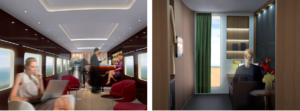Last week the Swedish Transport Administration released a report as a result of a government assignment in order to investigate possible opportunities to procure sleeper services from Sweden to the European continent. The report is only available in Swedish but below is a summary and some reflections.

Possible design concept for night train sleepers between Stockholm and Brussels (Illustration: LundbergDesign)
Despite the long distance from the European continent to Scandinavia almost all international train traffic currently consists of day train services. There is only one sleeper service during the summer season between Malmö and Berlin under the brand Snälltåget, which uses the ferry line Trelleborg – Sassnitz. The shipping company Stena Line has announced that the ferry line will be shut down and the train operator Transdev has applied to run the trains through Denmark instead.
The market share for train travel from Sweden to the European continent only consists of 1%. Anyhow, a market survey indicates that there is a considerably greater interest in travelling by train to the continent if there were better supply of services. 21% of the Swedish respondents found a possible night train concept to southern Germany very attractive and 41% found it quite attractive.
The investigation reflects on what may be a reasonable travel time with a sleeper, and notes that maximum 12 hours would be reasonable for a business traveler, but up to 17 hours for leisure travelers. The inquiry recommends to introduce a night train service Malmö-Cologne-Brussels as a first step. A Stockholm-Brussels line would be desirable but would mean a long duration, approximately 17 hours before the Fehmarn Belt connection between Denmark and Germany that will completed in 2028, and then 15 hours. However, the sleepers that are running Stockholm – Kiruna today takes 15 hours and serves lots of business travelers to the mining company LKAB.
The report presents a cost estimate (loss) for possible destinations:
- Malmö-Cologne (900 km) 9 h 5,5 million € / year
- Malmö-Brussels (1,100 km) 11 h 4,7 million € / year
- Stockholm-Brussels (1,700 km) 17 h 5,1 million € / year
- Stockholm-Hamburg (1,100 km) 11 h 4,2 million € / year
- Oslo-Gothenburg/(Stockholm)-Hamburg 8,4 million € / year
The destination Stockholm-Brussels causes the largest number of passengers, gets the best cost coverage ratio, and lead to the least cost per person km. Services with older rolling stock would reduce capital costs but expect to give higher maintenance costs and lower revenues due to lower willingness to pay.
The investigation finds that it is difficult to get sleeper services profitable under current conditions. New rolling stock with more effective compartment arrangements or innovations that combine cabins for day and night services, could provide better profitability, but will take time to develop. Other societal changes such as higher airfares, increased willingness to pay for night trains and development of a coherent ticket system for international train tickets could improve profitability in the future.
There are several technical challenges to operate international train services. Currently there are different electrification systems, which requires multi-power locomotives when running through Denmark, Belgium or France. The loading gauge is different on the European continent than in Sweden which does not allow Swedish carriages to be used. The locomotive also needs to be equipped to manage different signaling systems and other requirements for tunnels fire safety. In addition, the onboard staff must be able speak all languages in the countries bypassed.
The investigation propose that the procured operator initially should be responsible to provide rolling stock for the service. Sleeper carriages in a reasonable condition and locomotives that can handle the technical requirements deemed to be in short supply at present. Ordering a new rolling stock would require a long-term financial commitment for an operator with a depreciation period of 25-30 years. The inquiry finds that the operator in charge has to be the part applying for path allocations. As an infrastructure manager, the Swedish Transport Administration cannot apply.
There are two possible ways of procuring services in accordance with the regulation (EC) 1370/2007, direct awarding or a competitive tendering procedure. A direct allocation is expected to implement the service faster. However, direct allocation must be applied restrictively. With direct allocation, a procured night train service could start no earlier than 2022. Procurement in competition would prolong the process one year.
A procurement according to the regulation needs to be justified, for example by the reason that the current market does not offers climate-friendly and time-efficient trips at night between Scandinavia and Western Europe. The Swedish Transport Administration stresses that these services also would enable an improved connection to the rest of Europe’s coherent transport system. DG Move has been asked if the Commission considers that procured night train services, could be justified for the above reasons.
The Danish Transport Ministry has welcomed a cooperation with the Swedish authorities to support night train service through Denmark. The situation is contrariwise in Germany, because there is no national body that can agree on public service obligation for interregional traffic, and all interregional service should be commercial based. However, it may be possible at an interstate level to agree on public service obligation for affected regions in Germany. On the other hand, the Belgian Ministry of Transport states to the Swedish Transport Administration that they don’t mind if a night train service subsidized in Sweden and Denmark would proceed on a commercial basis through Germany to Brussels, but they were doubtful to apply public service obligation agreements all the way to Brussels. The Swedish Transport Administration has consulted the Commission’s Legal Service to find out if it would be possible to apply a solution where public service obligation could be valid only at a part of the line through Sweden and Denmark and that the rest would be commercial, but until now they have got no response.
The investigation finds that in order to enable a quick start of the service, the operator must use existing rolling stock. During the first contract period, proposed for four years, an evaluation should be made to provide a basis for deciding on a possible continuation. If the service succeeds in achieving established objectives but is still not considered as commercially viable, a continuing procurement period may be justified, the investigation notes. At that time, it could be relevant for the state to purchase a dedicated fleet or procure an operator to obtain a new rolling stock. A service with a dedicated new fleet is expected to be possible earliest by 2028.
The report is very comprehensive and consists of over hundred pages and reflects a benevolent intention by the Swedish Transport Administration to implement a state supported night train service from Scandinavia to Western Europe, initially procured for four years with existing rolling stock. The public interest travelling climate-friendly by train has grown explosively and the most efficient way spending travel times that often exceed 12 hours from Scandinavia could be an attractive alternative to flying. With modern carriages a night train experience could be interesting both for business and leisure travelers even if the travel time would be 15 hours. Departure at 18.00, starting with a dinner at the on-board restaurant, then a full night’s sleep in well-equipped cabins with own shower and WC, and in the morning a breakfast on board and arrival at 09.00 would make the trip very reasonable despite the long travel time. A strategic destination would be Stockholm-Copenhagen-Cologne-Brussels in order to attract both business and leisure travelers. A longer travel time of 15 hours would also maximize the utilization of carriages, will be used two thirds of the whole day. The investigation’s cost benefit analysis also states this destination causes the largest number of passengers, gets the best cost coverage ratio, and lead to the least cost per person km. The initially calculated loss 5,1 million € for establishing daily night train services between Brussels and two Scandinavia capitals can be compared to the cost of 2 million € that the City of Stockholm every year spends on public flower arrangements. It is likely that traveling long distances by train will increase once this sleeper service has been introduced, which will also increase the demand and willingness to pay. I think the service will commercially viable soon. However, it is crucial to initiate a process in order to enable modern sleeper carriages as soon as possible otherwise the demand may be reduced which would limit the profitability.
The entire report (in Swedish) can be downloaded here.
Emil Frodlund, EPF Board Member


 Stay informed!
Stay informed!